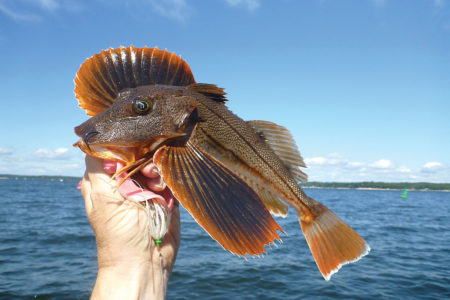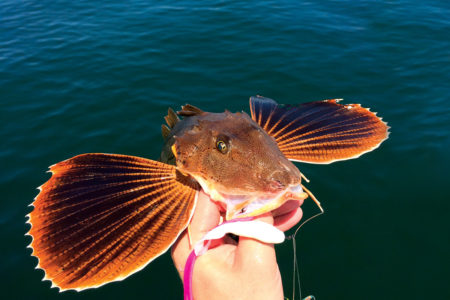Dreamboating in June means bird hunting on fluke bottom.
The sea robin doesn’t get a lot of respect in the angling world. It’s typically a fish that fools the caster into thinking they’ve hooked the fish they were actually looking for, maybe a fluke, a weakfish, sea bass, jumbo porgy…something else, something other than a sea robin. And until its inception into the hallowed pantheon of species on the Dreamboat Challenge leaderboard, a sea robin was nothing more than strange-looking bycatch, tossed back without fanfare.
But then, it was decided that the lowly sea robin would replace the most regal of the northeast gamefish, the striped bass, on the Dreamboat leaderboard. Overnight, anglers went from unceremoniously hurling these weird, winged bottom dwellers back into the ocean, to wishing they’d paid more attention to the conditions that lead to their capture. It seemed that no one was an expert on catching sea robins!
Some Things You Didn’t Know
Sea robins are part of a family of fishes called ‘triglidae’ which are mostly reddish, orange or brown in color and possess large, wing-like, pectoral fins – these traits have led to all species of triglidae being referred to as sea robins, regardless of subspecies. These fish can reside in waters as deep as 700 feet, but can be found in almost any depth in the waters of the western Atlantic coast.
Something else that’s interesting about sea robins in that they have three ‘walking rays’ on each side of their body. These rays separate from their pectoral fins when they are developing and the fish use them to ‘walk’ along the bottom of the ocean and to feel for prey hiding in the sand or mud using a sense called ‘chemoreception’, which is just a fancy way of saying that they are highly sensitive to certain amino acids that are present in some species of marine invertebrates. If you’ve caught a sea robin, you’ve probably heard them grunting. This comes as a result of a unique drumming muscle that makes the guttural sounds by banging on the swim bladder. When you hear that grunting, it’s not hard to understand why sea robins are also called gurnards in other parts of the world.
To Catch A Triglidae
If I was the type that liked to joke around, and I am, I would say the best way to catch to sea robin would be to target some other species with bait and maybe bring less bait than you think you’ll actually need. It’s no different than tossing soft plastics for stripers, if you don’t bring many, the bluefish will find them – so I’d have to assume if I only brought a little bait, the birds would find me too. But in all seriousness, my experience has shown that sea robins seem to increase their feeding during periods of slow or slack tides. Maybe they like slow tides because they have those two giant sails on their sides…or maybe not.
Nearly all of the sea robins I have caught have taken some kind of artificial lure, small soft plastics like Bass Assassins on a light jighead, fished just above the bottom during tide changes seems to be a good way to hook a few. For the record I’ve seen a few taken on Clouser Minnows as well. And, I seem to find them in places where other bottom fish are prevalent—like porgies, sea bass and fluke.
But I am not an expert in sea robin angling and I don’t know that anyone is. However, the closest thing to a sea robin expert you’re going to find is a charter captain that fishes for sea bass and fluke, so I called my good friend Captain TJ Karbowski of Rock and Roll charters who runs out of Clinton, CT. I asked TJ how he catches the biggest sea robins on his boat every year. He said, “Well first of all, I have to be honest, I have never actually tried to catch a sea robin, they’re just a byproduct of fishing every day. But one of the ways that we do catch some bigger sea robins is, believe it or not, on umbrella rigs.”
He went on to say, “I’m on my boat now and guarantee you, if we swapped out the bunker spoons for umbrellas and scraped the bottom, we’d start catching sea robins.” He also reiterated my point about slow tides, “Sea robins are the kings of slack tide, so if I had to catch a big sea robin, I would fish the end the tide on the same bottom where I fish for fluke and sea bass.”
So this month, when the tide falls slack, bait a hook or drag an umbrella and see if you can find your way to the top of the Dreamboat leaderboard. Glory doesn’t always come with the catch of a revered gamefish, sometimes it grunts and has big, unwieldy wings for fins. And as TJ reminded me, “Sea robins are actually really good to eat and if you cube up their fillets and put them into a lobster bisque, you’ll have a really hard time telling the difference.”



